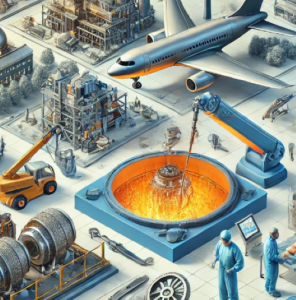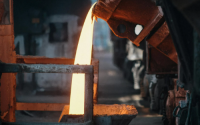WHICH INDUSTRIES RELY ON HIGH MELTING POINT METALS?
Introduction
In the rapidly advancing world of industry, materials science is pushing the boundaries of what is possible. Among them, high melting point metals stand out for their exceptional ability to withstand extreme temperatures without losing their structural integrity. These metals are the backbone of many critical applications, from aerospace engineering to nuclear power generation.
Industries that rely on high melting point metals include:

1. Aerospace Industry
– Application: High melting point metals are used in the manufacturing of turbine blades, engine components, and heat shields for aircraft and spacecraft. These metals can withstand the extreme temperatures encountered during flight and re-entry.
– Example Metals: Titanium, nickel-based superalloys, and tungsten.
Related reading: High-Temperature Materials in Aerospace
2. Nuclear Industry
– Application: Components in nuclear reactors, such as control rods, fuel rods, and cladding materials, require metals that can maintain their structural integrity under high-temperature conditions and radiation exposure.
– Example Metals: Zirconium, hafnium, and tungsten.
Related reading: Why are Refractory Metals Used in Nuclear Reactions?
3. Metalworking and Tooling Industry
– Application: High melting point metals are used to create tools, dies, and molds that must endure the stresses and temperatures of metalworking processes like forging, casting, and machining.
– Example Metals: Tungsten carbide, molybdenum, and tantalum.
Related reading: Top 10 Materials with the Highest Melting Point in the World
4. Chemical Processing Industry
– Application: Equipment and components used in chemical processing must resist corrosion and maintain performance at high temperatures. High melting point metals are used for reactors, heat exchangers, and piping.
– Example Metals: Tantalum, platinum, and molybdenum.
5. Power Generation Industry
– Application: High-temperature components in power plants, including gas turbines, boilers, and heat exchangers, rely on high melting point metals to ensure efficiency and longevity under continuous operation.
– Example Metals: Nickel-based superalloys, tungsten, and molybdenum.
6. Defense and Military Industry
– Application: High melting point metals are used in armor plating, missile components, and other military hardware that must perform under extreme conditions.
– Example Metals: Tungsten, titanium, and molybdenum.
7. Electronics and Semiconductor Industry
– Application: High melting point metals are used in the production of semiconductors, where they form part of the circuitry that operates reliably under high temperatures.
– Example Metals: Molybdenum, tungsten, and tantalum.
8. Glass and Ceramics Industry
– Application: Equipment used in the manufacturing of glass and ceramics, such as kilns and furnaces, requires materials that can withstand extremely high temperatures without deforming.
– Example Metals: Platinum and tungsten.
9. Automotive Industry
– Application: High-performance engines and exhaust systems use components made from high melting point metals to handle the extreme temperatures generated during operation.
– Example Metals: Nickel-based superalloys and titanium.
10. Oil and Gas Industry
– Application: High melting point metals are used in drilling equipment, valves, and components that must perform in harsh, high-temperature environments found deep underground.
– Example Metals: Inconel (a nickel-chromium alloy) and titanium.
Conclusion
High melting point metals are critical to the functioning of many modern industries, including aerospace engineering, nuclear power, the automotive industry, and chemical processing, these metals are the unsung heroes that enable technological progress and industrial efficiency.
As industries continue to evolve and the demand for high-performance materials grows, the role of high melting point metals will only become more integral in shaping the future of technology and industry. For more information, please check Advanced Refractory Metals (ARM).
Related Posts

The Metal with the Highest Melting Point

Industrial Applications of Refractory Metal Molybdenum

